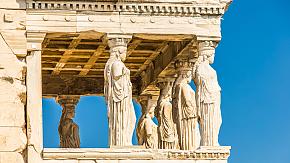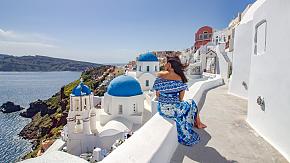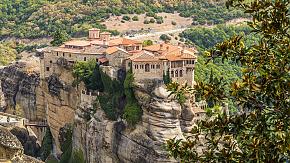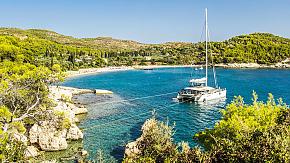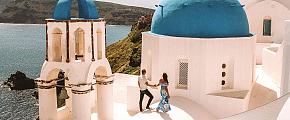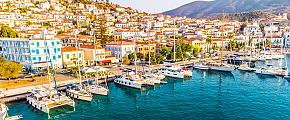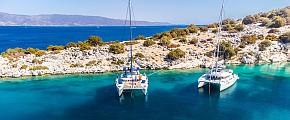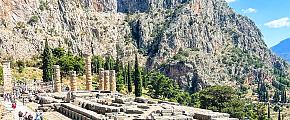Everything to Know About the Acropolis of Athens
The Acropolis of Athens, which dates back to the 5th century BCE, houses the Parthenon, Erechtheion, Temple of Athena Nike and other buildings that symbolize Greek spirituality and civilization, attracting millions of visitors every year. Visitors can see magnificent temples, elegant Caryatids, sculptures and paintings depicting the stories of the goddesses and gods, and enjoy large performances in the nearly 2,000-year-old theater. Here you will find highlights of the Acropolis, and answers to the most-asked questions about traveling to the Acropolis.
What to See in Acropolis of Athens
Parthenon
Parthenon, the most important surviving ancient Greek structure, is located on the top of the Acropolis of Athens, built between 447 BCE and 432 BCE in honor of the Greek goddess Athena. Known for its stately marble columns and perfect sense of proportion, the Parthenon has been named the most beautiful building in the world, according to Business Insider.
Parthenon is the quintessential Doric temple, supported by 46 Doric columns and covering 2,300 square feet. The Doric columns are majestic, with 20 grooves on each one, which give the temple different colors at different times of the day, from greenish gray in the morning to golden when the sun sets. The proportions of the temple's facades, roof and pedestal are all close to the Golden Section, giving a sense of harmony. The columns and foundation are slightly arched, which is a very reasonable use of the illusion of human eyes, making the temple appear more upright and stable. Parthenon boasts many masterpieces, including sculptures on its frieze depicting the Panathenaic procession to the Acropolis, and 92 carved metopes on its exterior walls depicting mythical battles, such as the famous Gigantomachy, Trojan War, Amazonomachy, and Centauromachy.
 Parthenon
Parthenon
Erechtheion
Located on the north side of the Parthenon, Erechtheion was built between 421-405 BCE in dedication to Athena and Poseidon. It is a typical representative of Ionic architecture, with slender columns and scrolled capitals, and has an elegant and noble femininity.
Erechtheion consists of the main building, the south porch and the north porch. The north porch has six Ionic columns, and its Ionic frieze is decorated with carved gods, heroes and mortals. The south porch boasting its Caryatids (figures supporting a roof) is the most famous of this temple, with six elegant statues of maidens replacing columns, carrying the marble roof. Each statue is lifelike and stands gracefully in a beautiful long dress. There are different opinions about their identity, some believe they are mourners of the Athenian king Cecrops, and some believe they are attendants of the goddess Athena. Due to the heavy weight of the roof, the necks of the six maiden statues had to be thick enough, but this would affect their aesthetics. So the architect added a flower basket to the head of each statue, successfully solving this architectural aesthetic problem and making the six statues world-famous.
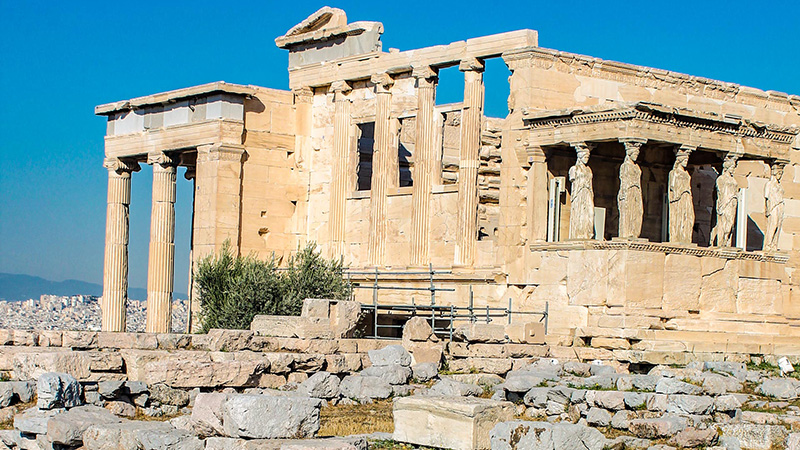 Erechtheion
Erechtheion
Odeon of Herodes Atticus
Odeon of Herodes Atticus is a semi-circular amphitheater located at the bottom of the southwest slope of the Acropolis, built in 161 CE by Roman philosopher Herodes Atticus as an ode to his late wife.
The theater is a three-story building with a seating area of 32 rows of seats from high to low, for over 6,000 spectators, and you can see the performances on stage from anywhere in the seating area. The theater is known for its exemplary acoustics, and today you can enjoy performances of the Athens Festival, concerts and classical tragedies here, all of which take place from May to the beginning of October. Tickets for the shows can be purchased outside the theater, but it is recommended to book in advance so that there are more seats for you to choose from.
The stairs to the rows are steep and flat shoes are highly recommended. You can buy tickets according to your needs, choose the lower rows you can climb fewer stairs, choose the higher rows you can get a more open view. The theater's opening hours depend on the performances. Note that no pictures are allowed during the performances.
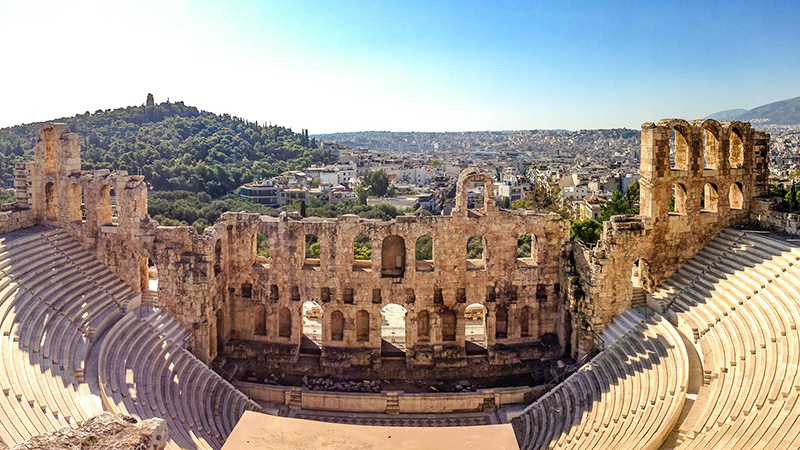 Odeon of Herodes Atticus
Odeon of Herodes Atticus
Propylaea (Propylaia)
Propylaea is an imposing structure built from 437 to 432 BCE as a gateway to the Acropolis. Today, as the original staircase has been lost, visitors enter and leave Propylaea via a ramp built for them.
It consists of the central building, the north wing and the south wing. The solemn central building has six majestic Doric columns at the entrance, three pairs of elegant Ionic columns in the lobby, and colorful decorations on the ceiling. The north wing, which is relatively well preserved and decorated with painted panels, is a gallery housing the masterpiece "Achilles on Skyros" by the painter Polygnotus. When you come out of Propylaea, you can see the Parthenon on your right at first glance.
Temple of Athena Nike
The Temple of Athena Nike is right next to the Propylaea. Nike means victory in ancient Greece, and the Temple of Athena Nike was built between 427 and 424 BCE to commemorate the Greek victory in the Battle of Persia.
The temple houses a large marble statue of the goddess Athena, without wings. In her right hand, she holds a pomegranate, a symbol of fruitfulness and peace, and in her left hand, she holds a helmet. In Greek art, Athena was usually depicted with wings, and the Greeks deliberately fashioned this wingless statue in the hope that the goddess would remain in Greece forever and bring them victory. The friezes of the temple have elaborate decorations depicting the meeting between the gods Athena, Zeus and Poseidon.
When Is the Best Time to Visit the Acropolis
The best time to visit the Acropolis is from October to April, when the outdoor temperature is pleasant and you don't need to spend too much time in the queues. If you visit the Acropolis between May and September, it is best to go in the morning, when there are not so many tourists and the weather is not as hot as in the afternoon.
When Is the Acropolis Open
The Acropolis has different opening hours for summer and winter. During the summer months (1 April to 31 October), the Acropolis opens at 8:00 AM every day. However, the closing times vary. On Mondays, it closes at 4:00 PM, on Fridays at 10:00 PM, and on Tuesdays to Thursdays and Sundays at 8:00 PM. During the winter season (1 November to 31 March), the Acropolis opens at 9:00 AM and closes at 5:00 PM from Monday to Thursday, closes at 10:00 PM on Friday, and closes at 8:00 PM on Saturday and Sunday. Visitors are allowed entry during the opening hours and up to 30 minutes before closing each day.
In addition, the Acropolis is closed on January 1, March 25, May 1, Easter Sunday, December 25 and 26. In the summer, visiting the Acropolis in the morning is recommended, as it closes from noon to 5 p.m. if the temperature is too high.
How Long Does It Take in the Acropolis
With enough time, you can explore the entire Acropolis and schedule your stay at each building according to your interests, and the whole tour usually takes 6-7 hours; if you are short of time, do not miss the Parthenon and Erechtheion, which take about 3 hours. From May to early October there are often big shows held at the theater Odeon of Herodes Atticus, so if you come across one, don't miss it, the theater's excellent acoustics are worth another 2 to 3 hours.
How to Get to the Acropolis
You need to first reach the Athens International Airport, where flights from various countries and cities are accepted. From Athens International Airport you can easily get to the Acropolis by metro, bus, or car.
Athens has three metro lines, the Blue, Red and Green lines. From Athens International Airport, you can take the Blue line, which terminates at Dimotiko Theatro, to Syntagma station, then transfer to the Red line in the direction of Elliniko and get off at Acropoli station, which is a 2-minute walk to the Acropolis. The whole trip takes about one hour.
You can also take the X95 bus from Athens International Airport to the Acropolis. The bus stop is right outside the airport terminal and the buses usually depart every 20 minutes. You first need to buy a bus ticket at the ticket counter, noting that the ticket is valid for 90 minutes. Take the bus to Syntagma station and get off there, and then walk 1.5 km to the Acropolis. The whole trip takes about 75 minutes.
If you are bringing a lot of luggage, it is best to reserve a car in advance or take a taxi from Athens International Airport, which is about a 30-minute drive to the Acropolis. If you are traveling in your own car, you can park at Metropark Athens, about a 10-minute walk from the Acropolis, which is open from 7:30 a.m. to 1:30 a.m. the next day Monday through Thursday and 24 hours a day Friday through Sunday.
Is It Hard to Climb to the Acropolis
It takes some effort to climb up to the Acropolis. You need to climb several sets of steps to reach the Acropolis, which takes about 15-20 minutes, and you can stop and sit on the steps at any time along the way to rest. Note that some steps are slippery, so climb slowly. You can also take the elevator, which is about 350 meters from the ticket office located at the west end of the Acropolis, and you need to contact the staff there in advance.
Should I Get a Tour Guide for the Acropolis
The advantage of having a guide is that you will be able to visit the buildings on the Acropolis more efficiently, the guide will tell you the highlights of each building and the story behind it, and an experienced guide can also help you avoid the long queues. Just take the tour completely at your own pace.
What to Bring and Wear When Visiting the Acropolis
There are some slightly steep steps and slopes throughout the journey, please wear comfortable, non-slip walking shoes so that your whole journey will be more enjoyable. Sunscreen and sunglasses are best to bring no matter what the season, as there is no shade outside the buildings. Remember to bring water in the summer, when it is hot and dry outside. You can also bring an umbrella in case it rains.
Don't miss this popular tourist destination in Greece and put it on your travel bucket list. If you're ready to go, then let's go! Let Odynovo help you to make your Greece vacation come true!
What Our Clients Say
Explore the latest verified reviews of Odynovo's travel services on Tripadvisor, Google, Trustpilot, Product Review and more trusted platforms.

